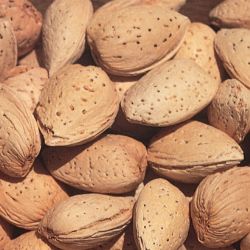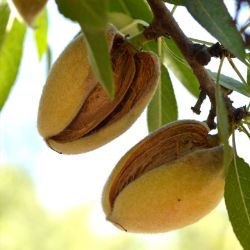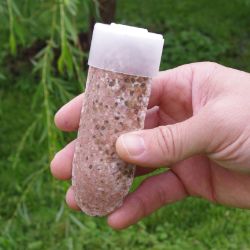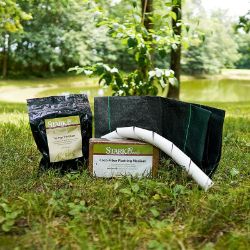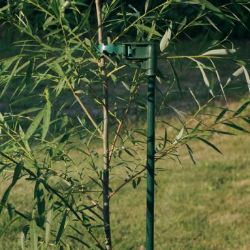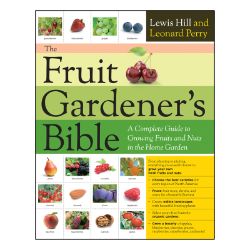Pest & Disease Control for Almond Trees
Every tree has the future potential for disease and insect damage. Factors such as location and weather will play a part in which issues your tree encounters. If available, disease-resistant trees are the best option for easy care; and for all trees, proper maintenance (such as watering, fertilizing, pruning, spraying, weeding, and fall cleanup) can help keep most insects and diseases at bay.
NOTE: This is part 7 in a series of 11 articles. For a complete background on how to grow almond trees, we recommend starting from the beginning.
Crown Gall
Trees appear stunted and slow growing; leaves may be reduced in size, little or no fruit. If tree is dead, inspect roots for hard, woody ‘tumors’. Note: many things can cause stunted trees.
Control
- Consult County Extension Agent
Botrytis Shoot Blight
On 1-year-old shoots, reddish spots develop into sunken cankers. Spots on leaves, center often drops out, leaving small holes. Fruit skins usually are spotted; damage to nutmeat unknown. If NOT controlled, production will be reduced.
Natural Control
- Monterey Fruit Tree Spray Plus
Scale
Usually on bark of young twigs and branches, encrusted with small (1/16”) hard, circular, scaly raised bumps with yellow centers, may also be on fruit. Sap feeding weakens the tree.
Natural Control
- Monterey Fruit Tree Spray Plus
- Safer® Brand Insect Killing Soap
Powdery Mildew
Whitish-gray powdery mold or felt-like patches on buds, young leaves and green twigs. Leaves may crinkle and curl upward. New shoots are stunted. Over winters in fallen leaves.
Natural Control
- Monterey Fruit Tree Spray Plus
Leafroller
Pale yellow or ‘dirty’ green worms. Leaves are rolled and webbed together where insects feed. Eventually becomes ‘skeletonized’.
Natural Control
- Hi-Yield® Vegetable & Ornamental Insect Contro
- Monterey Fruit Tree Spray Plus
Blossom Blight
Flowers turn brown prematurely. Nuts rot similar to brown rot in peaches. Start as small brown spots, which rapidly enlarge. Fall clean up is important.
Natural Control
- Monterey Liquid Copper Fungicide
- Monterey Fruit Tree Spray Plus
Leaf Spot
Appears as black or brown spots on underside of leaves. Center often falls out leaving a ‘shot hole’ appearance. Leaves may yellow and fall. Fruit will also get spots, sunken areas and cracks.
Natural Control
- Monterey Liquid Copper Fungicide
Scab
Young shoots have water-soaked spots which turn brown. Leaves turn black and drop early. Olive colored circular spots on fruit.
Natural Control
- Monterey Fruit Tree Spray Plus
Lesser Peach Tree Borer
Adults of this insect are clearwing moths, metallic blue to black in color with bright bands of orange or yellow. They are about 13 mm long with wings folded and their forewings have a black apical band. Larvae are about 18 mm long, white with brown heads.
Symptoms:
- Build up of reddish brown frass and gummy exudates known as gummosis. Check branch crotches on larger branches or upper trunk.
- Heavy infestation may cause branch dieback.
- Young tree maybe girdled and killed older trees may be weakened.
Chemical Control
- GardenTech® Sevin® Bug Killer
Navel Orangeworms
Caterpillar is ¾ inch long, reddish orange to yellow. Adult moths have irregular, silver gray and black forewings and legs, snout like at front of the head. Eggs are white at first and later orange before hatching. Larvae are reddish orange then vary from milky white to pink. Pupae are light to dark brown. Larvae bore into nutmeat and later consume most of the nut. Producing large amounts of webbing and a fine powdery residue. Over winter in mummy nuts in tree or on the ground.
Natural Control
- Hi-Yield® Vegetable & Ornamental Insect Control
- Removal of unharvest nuts.
Chemical Control
- GardenTech® Sevin® Bug Killer
Mites
Pinpoint size, many different colors. Found on undersides of leaves. Sap feeding causes bronzing of leaves. Severe infestations have some silken webbing.
Natural Control
- Safer® Brand Insect Killing Soap
- Monterey Fruit Tree Spray Plus
Plant Bugs
Insects are ¾ to 1" in length, usually brown in color, have long legs, wings and antennas. They feed on plant tissues that results in tan or bleached spots and distortion. Females lay eggs on the leaves or stems. Can cause nuts to fall early and/or be poorly developed.
Natural Control
- Safer® Brand Insect Killing Soap
- Monterey Fruit Tree Spray Plus
Tent Caterpillar
Hairy caterpillars that enclose large areas in webbing and feed on enclosed leaves. Remove web with rake and burn. Caterpillare are pulled out with webs.
Natural Control
- Natural Guard® Caterpillar Killer Spray w/BT
Chemical Control
- GardenTech® Sevin® Bug Killer
Peach Twig Borer
Adult moths are gray in color and about 1/4 to 1/2 inch in length. Larvae are small brown caterpillars that tunnel into young shoots, killing terminal growth and nuts as they ripen.
Natural Control
- Hi-Yield® Vegetable & Ornamental Insect Control
Chemical Control
- GardenTech® Sevin® Bug Killer
Shothole
Small reddish-purple spots appear on young leaves then enlarge and eventually dropping out of the leaf blade leaving a “shot hole.” It appears on fruit, usually in clustered as light brown spots or lesions with dark purple margins.
Natural Control
- Monterey Liquid Copper Fungicide













